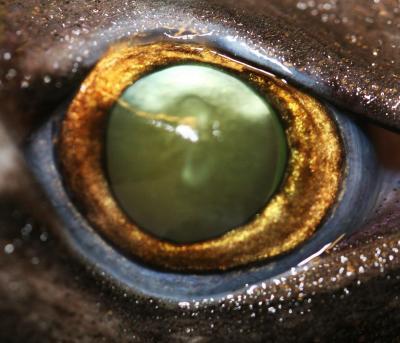Lanternsharks produce and perceive bioluminescent light in order to communicate, find prey, and camouflage themselves against predators in the mesopelagic twilight zone.
The mesopelagic twilight zone is 200-1000 meters deep in the sea - a vast, dim habitat, where, with increasing depth, sunlight is progressively replaced by point-like bioluminescent emissions. To better understand strategies used by bioluminescent predators inhabiting this region that help optimize photon capture, the authors of a new study analyzed the eye shape, structure, and retinal cell mapping in the visual systems of five deep-sea bioluminescent sharks, including four Lanternsharks (Etmopteridae) and one kitefin shark (Dalatiidae).
They found that the eyes of deep-sea bioluminescent sharks have a higher rod density when compared to non-bioluminescent sharks. The translucent area present in the upper eye orbit of the lantern sharks might aid in adjusting counter-illumination or in using bioluminescence to camouflage the fish. They also found several ocular specializations, such as a gap between the lens and iris that allows extra light to the retina, which was previously unknown in sharks.

The eye of a velvet belly lanternshark. Credit: Dr. J. Mallefet (FNRS/UCL)
Comparisons with previous data on non-bioluminescent sharks reveals that bioluminescent sharks possess higher rod densities in their eyes, which might provide them with improved temporal resolution, particularly useful for bioluminescent communication during social interactions.
"Every bioluminescent signal needs to reach a target photoreceptor to be ecologically efficient. Here, we clearly found evidence that the visual system of bioluminescent sharks has co-evolved with their light-producing capability, even though more work is needed to understand the full story," said the lead author.
These results reveal an unexpected diversity of photon capture strategies and indicate that like other deep-sea animals, deep-sea sharks possess a number of adaptations to cope with the twilight zone.

doi:10.1371/journal.pone.0104213
Citation: Claes JM, Partridge JC, Hart NS, Garza-Gisholt E, Ho H-C, et al. (2014) Photon Hunting in the Twilight Zone: Visual Features of Mesopelagic Bioluminescent Sharks. PLoS ONE 9(8): e104213. doi:10.1371/journal.pone.0104213





Comments